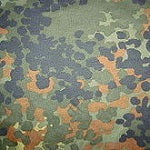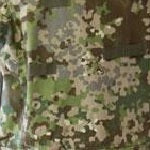
How the Flecktarn came into the Federal Armed Forces
How the Flecktarn came into the Federal Armed Forces
Military clothing of German troops in the period from the First World War to today
After a standardized dress of the armies in the 14th century, nations were keeping in the following centuries to represent the state power through uniforms and to represent a visible unity.
Camouflage pattern of the German Imperial Army, Reichswehr, Wehrmacht, and the Waffen-SS
The Imperial Army already used, in the time of the WWI a various camouflage patterns. Colors and shapes were arranged in such a way that they were suitable for making it challenging to locate the soldiers and their military equipment.
That was a move away from the view that it had until then that camouflage was not virtuous and was a cowardly trait.
Therefore, before camouflage patterns came into the ranks of the armies, they were based on garish colors. The reason was that soldiers were still fighting in short distances, and so they could better see on the battlefield who was a friend and who was the enemy. Especially under the use of black powder weapons, the soldiers were often enveloped by dense powder mist, which required an optical underline of the affiliations.
Because the fighting became out of distance, by the technical progress due to distance weapons such as the MG, camouflage clothing was existential. Even at the time of WWI, it was gradually separated from colorful clothing. The brightly colored deployment outfit and the color of the large units could not be replaced immediately. They tried to protect vehicles and troops with foliage from the forest or moved mainly at night. Nevertheless, it was not the case that due to the striking color design, high losses were to be lamented.
As from July 1918, primarily military large appliances and equipment with a colored paint (sharp-edged spots in rust, ochre, green, black) were camouflaged, the uniforms should soon be overhauled as well. The lengthy process to transform the clothing in eye-catching signal colors towards advantageous Tarnbekeidung has been stalled again and again due to financial hardship or lack of material.
 |
 |
 |
The original camouflage clothing moved in uniform grey, later in olive green (hue Ral 6014, also: NATO-olive).
Meanwhile, the color design of the combat outfit is based on the mission theater and is multi-colored.
Already the Reichswehr used in the year 1931 splinter camouflage, 1938 the first units of the Waffen-SS were equipped with camouflage clothing in various versions (Blocktarn, Platanenmuster, Rauchtarnmuster, Palmenmuster, Beringtes Eichenlaubmuster, Eichenlaubmuster, Erbsenmuster, Telo Mimetico, Leibermuster)
 |
 |
 |
 |
 |
 |
 |
 |
 |
 |
Development of camouflage patterns in the postwar period
After founding of the Federal Armed Forces in 1955, the treaties of the EVG should handle a single uniform style and camouflage pattern between the six-member countries but failed. So, Germany must develop a new BDU by itself within a short period. For the time being, it was possible to revert to already proven camouflage clothing. For a short time, a variant of the Leibermusters was worn. Since this was associated with the Waffen-SS, however, (there were similarities with the Erbsenmuster) left-hand political movements of the postwar period with the aim of detaching from the past, increased the pressure in the years from 1956 to 1970 for developing alternative camouflage clothing (splinter camouflage M56, then in the 1960s monochromatic in Nato-olive.
 |
 |
 |
In the 1970s there was a development phase of new camouflage motifs (Flecktarn A, Flecktarn B, and Felcktarn C). With Flecktarn B (large), the best results were achieved during the 76-troop trial. Left-hand political resistance movements and financial bottlenecks, however, did not allow the supply in this color before the 1990s.
After a further test phase in the years from 1987-1990, the Bundeswehr introduced the five-colored Tarnmotiv Flecktarn-B (5-colour-ft) on February 20, 1991. The camouflage pattern in the colors black and brown and three shades of green in different nuances was developed based on the color spectrum of the European mixed forest in a map composition. The colored surfaces are of varying sizes and are in print side by side or multi-layered. Older variations are equipped with a reddish brown, newer with a deep brown.
 |
 |
 |
In the past, Flecktarn has proven itself in its camouflage effect in wooded terrain in comparison with NATO partners. Even in the near infrared area, Flecktarn-B (large) performs by its fabrics and colors particularly well and has always been used in certain operations.
Now Flecktarn is not only used by the Federal Armed Forces of Germany but is in use internationally.

Due to the expanded out of area missions of the armed forces, the 5-color Flecktarn had to be adapted to topical applications. The reaction was carried out with the Tropentarnmotiv.
Tropentarn (also: 3-color Flecktarn or 3-color FT) is a camouflage pattern for low-vegetation areas developed in the early 1990s and used by the Federal Armed Forces in the army and the airforce. The pattern corresponds to the Flecktarndruck. Differences are found only in the color scheme. The bright color mixture in a primarily sand-colored clay with small, round olive green and ocher-colored spots, the human silhouette on sandy soil and in steppe or desert areas merge with their environment.

Outlook
Flecktarn B was developed for the German mixed forest and therefore optimal in wooded terrain. For other locations, however, the Flecktarn pattern is not equally suitable.
Therefore, the Wehrwissenschaftliche Institut für Werkstoffe and Betriebsstoffe follows the American camouflage pattern "Multicam" following, now almost three years primarily two new uniforms (multi-camo suits for regions with less forest growth and a new Winterflecktarnanzug), to provide better protection to the German soldiers in other countries.
The snow camo suit is based on a white Flecktarn pattern.
The six-colored multi-yarn pattern in brown, various shades of green, gray and beige combines the advantages of Flecktarn B and tropical camouflage in one pattern. The sand-colored shades of Tropentarn have been increased about the other shades. The uniform is thus suitable for a wide range of geographic textures. A blending of individual uniform parts and equipment, as it was previously necessary to be optimally protected, the soldier will be spared in the future. The camouflage adapts to the terrain background and average light conditions, is robust and can absorb heat radiation. The new multi-purpose suit also provides protection when handling night vision devices and residual light amplifiers. The camouflage effect is retained in the infrared range. An active deception of thermal imaging cameras is still not possible. Too complex is the interplay of humidity, fluctuating body, and ambient temperatures and UV radiation. However, it may take a while until the new uniforms are issued nationwide. As with the introduction of Flecktarnuniform in the 90s, the special forces are equipped primarily, later the support units. So far, there are the Multitarn suits only in small quantities; the procurement planning is not yet completed.
The new camouflage suit in Multitarn has been provided with design protection. Equipment in this style will not be freely available. So far it has happened again and again that different units dressed in Flecktarn camouflage and an assignment was no longer possible. Also, in the private or sportive area (Airsoft tactical Gameplay), the so-called military look had become increasingly popular. These demarcation problems will no longer occur in the future.
 |
 |